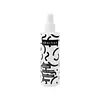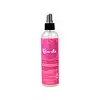What's inside
What's inside
 Key Ingredients
Key Ingredients

 Benefits
Benefits

 Concerns
Concerns

 Ingredients Side-by-side
Ingredients Side-by-side

Water
Skin ConditioningAloe Barbadensis Leaf Juice
Skin ConditioningCocos Nucifera Oil
MaskingCetyl Esters
EmollientCetyl Alcohol
EmollientGlycerin
HumectantQuaternium-91
Cetearyl Alcohol
EmollientLactic Acid
BufferingGlycidoxy Dimethicone
Cetrimonium Methosulfate
AntimicrobialButyrospermum Parkii Butter
Skin ConditioningPanthenol
Skin ConditioningMangifera Indica Seed Butter
Skin ConditioningPolysorbate 80
EmulsifyingDicetyl Phosphate
EmulsifyingCeteth-10 Phosphate
CleansingTocopheryl Acetate
AntioxidantPropoxytetramethyl Piperidinyl Dimethicone
Parfum
MaskingCaprylyl Glycol
EmollientSodium Lactate
BufferingPhenoxyethanol
PreservativePolyacrylamide
Sodium Benzoate
MaskingWater, Aloe Barbadensis Leaf Juice, Cocos Nucifera Oil, Cetyl Esters, Cetyl Alcohol, Glycerin, Quaternium-91, Cetearyl Alcohol, Lactic Acid, Glycidoxy Dimethicone, Cetrimonium Methosulfate, Butyrospermum Parkii Butter, Panthenol, Mangifera Indica Seed Butter, Polysorbate 80, Dicetyl Phosphate, Ceteth-10 Phosphate, Tocopheryl Acetate, Propoxytetramethyl Piperidinyl Dimethicone, Parfum, Caprylyl Glycol, Sodium Lactate, Phenoxyethanol, Polyacrylamide, Sodium Benzoate
Water
Skin ConditioningGlycerin
HumectantPolysorbate 80
EmulsifyingSimmondsia Chinensis Seed Oil
EmollientAloe Barbadensis Leaf Juice
Skin ConditioningPunica Granatum Fruit Extract
AntioxidantCocos Nucifera Fruit Extract
EmollientButyrospermum Parkii Butter
Skin ConditioningCocos Nucifera Oil
MaskingTriticum Vulgare Germ Oil
EmollientCamellia Sinensis Leaf Extract
AntimicrobialAnthemis Nobilis Flower Extract
MaskingHydrolyzed Silk
HumectantLeuconostoc/Radish Root Ferment Filtrate
AntimicrobialDisodium EDTA
Potassium Sorbate
PreservativeGuar Hydroxypropyltrimonium Chloride
Skin ConditioningCitric Acid
BufferingMethylheptyl Isostearate
Skin Conditioning1,2-Hexanediol
Skin ConditioningCaprylhydroxamic Acid
Phenoxyethanol
PreservativePropanediol
SolventSodium Benzoate
MaskingBenzyl Benzoate
AntimicrobialHydroxycitronellal
PerfumingCitrus Limon Fruit Extract
MaskingLinalool
PerfumingParfum
MaskingWater, Glycerin, Polysorbate 80, Simmondsia Chinensis Seed Oil, Aloe Barbadensis Leaf Juice, Punica Granatum Fruit Extract, Cocos Nucifera Fruit Extract, Butyrospermum Parkii Butter, Cocos Nucifera Oil, Triticum Vulgare Germ Oil, Camellia Sinensis Leaf Extract, Anthemis Nobilis Flower Extract, Hydrolyzed Silk, Leuconostoc/Radish Root Ferment Filtrate, Disodium EDTA, Potassium Sorbate, Guar Hydroxypropyltrimonium Chloride, Citric Acid, Methylheptyl Isostearate, 1,2-Hexanediol, Caprylhydroxamic Acid, Phenoxyethanol, Propanediol, Sodium Benzoate, Benzyl Benzoate, Hydroxycitronellal, Citrus Limon Fruit Extract, Linalool, Parfum
Ingredients Explained
These ingredients are found in both products.
Ingredients higher up in an ingredient list are typically present in a larger amount.
Aloe Barbadensis Leaf Juice comes from leaves of the aloe plant. Aloe Barbadensis Leaf Juice is best known for helping to soothe sunburns. It is also anti-inflammatory, moisturizing, antiseptic, and can help heal wounds.
Aloe is packed with good stuff including Vitamins A, C, and E. These vitamins are antioxidants, which help fight free-radicals and the damage they may cause. Free-radicals are molecules that may damage your skin cells, such as pollution.
Aloe Barbadensis Leaf Juice also contains sugars. These sugars come in the form of monosaccharides and polysaccharides, folic acid, and choline. These sugars are able to help bind moisture to skin.
It also contains minerals such as calcium, 12 anthraquinones, fatty acids, amino acids, and Vitamin B12.
Learn more about Aloe Barbadensis Leaf JuiceThis ingredient is also known as shea butter. It is an effective skin hydrator and emollient.
Emollients help soothe and soften your skin. It does this by creating a protective film on your skin. This barrier helps trap moisture and keeps your skin hydrated. Emollients may be effective at treating dry or itchy skin.
Shea butter is rich in antioxidants. Antioxidants help fight free-radicals, or molecules that may harm the body. It is also full of fatty acids including stearic acid and linoleic acid. These acids help replenish the skin and keep skin moisturized.
While Shea Butter has an SPF rating of about 3-4, it is not a sunscreen replacement.
Shea butter may not be fungal acne safe. We recommend speaking with a professional if you have any concerns.
Learn more about Butyrospermum Parkii ButterCocos Nucifera Oil is obtained from the kernels of the coconut fruit. In other words, this is coconut oil.
Coconut Oil is rich in fatty acids with lauric acid making up the majority of these. It also contains linoleic acid. Due to this high fatty acid content, coconut oil helps trap moisture and soften skin.
Despite being antibacterial, coconut oil may not be great for acne-prone skin. It is comedogenic and may clog pores. This ingredient may not be safe for malassezia or fungal acne.
Note: Coconut Oil should not replace your sunscreen for UV protection. Studies show it only blocks about 20% of UV.
This oil is non-volatile and has a light scent.
The term 'fragrance' is not regulated in many countries. In many cases, it is up to the brand to define this term. For instance, many brands choose to label themselves as "fragrance-free" because they are not using synthetic fragrances. However, their products may still contain ingredients such as essential oils that are considered a fragrance.
Learn more about Cocos Nucifera OilGlycerin is already naturally found in your skin. It helps moisturize and protect your skin.
A study from 2016 found glycerin to be more effective as a humectant than AHAs and hyaluronic acid.
As a humectant, it helps the skin stay hydrated by pulling moisture to your skin. The low molecular weight of glycerin allows it to pull moisture into the deeper layers of your skin.
Hydrated skin improves your skin barrier; Your skin barrier helps protect against irritants and bacteria.
Glycerin has also been found to have antimicrobial and antiviral properties. Due to these properties, glycerin is often used in wound and burn treatments.
In cosmetics, glycerin is usually derived from plants such as soybean or palm. However, it can also be sourced from animals, such as tallow or animal fat.
This ingredient is organic, colorless, odorless, and non-toxic.
Glycerin is the name for this ingredient in American English. British English uses Glycerol/Glycerine.
Learn more about GlycerinParfum is a catch-all term for an ingredient or more that is used to give a scent to products.
Also called "fragrance", this ingredient can be a blend of hundreds of chemicals or plant oils. This means every product with "fragrance" or "parfum" in the ingredients list is a different mixture.
For instance, Habanolide is a proprietary trade name for a specific aroma chemical. When used as a fragrance ingredient in cosmetics, most aroma chemicals fall under the broad labeling category of “FRAGRANCE” or “PARFUM” according to EU and US regulations.
The term 'parfum' or 'fragrance' is not regulated in many countries. In many cases, it is up to the brand to define this term.
For instance, many brands choose to label themselves as "fragrance-free" because they are not using synthetic fragrances. However, their products may still contain ingredients such as essential oils that are considered a fragrance by INCI standards.
One example is Calendula flower extract. Calendula is an essential oil that still imparts a scent or 'fragrance'.
Depending on the blend, the ingredients in the mixture can cause allergies and sensitivities on the skin. Some ingredients that are known EU allergens include linalool and citronellol.
Parfum can also be used to mask or cover an unpleasant scent.
The bottom line is: not all fragrances/parfum/ingredients are created equally. If you are worried about fragrances, we recommend taking a closer look at an ingredient. And of course, we always recommend speaking with a professional.
Learn more about ParfumPhenoxyethanol is a preservative that has germicide, antimicrobial, and aromatic properties. Studies show that phenoxyethanol can prevent microbial growth. By itself, it has a scent that is similar to that of a rose.
It's often used in formulations along with Caprylyl Glycol to preserve the shelf life of products.
Polysorbate 80 is a surfactant and emulsifier. It is used to keep ingredients together, and prevent oils and waters from separating.
It is made from polyethoxylated sorbitan and oleic acid. This ingredient can be found in cosmetics, foods, and medicine. It is water-soluble.
Polysorbate 80 may not be fungal acne safe.
Learn more about Polysorbate 80Sodium Benzoate is a preservative. It's used in both cosmetic and food products to inhibit the growth of mold and bacteria. It is typically produced synthetically.
Both the US FDA and EU Health Committee have approved the use of sodium benzoate. In the US, levels of 0.1% (of the total product) are allowed.
Sodium benzoate works as a preservative by inhibiting the growth of bacteria inside of cells. It prevents the cell from fermenting a type of sugar using an enzyme called phosphofructokinase.
It is the salt of benzoic acid. Foods containing sodium benzoate include soda, salad dressings, condiments, fruit juices, wines, and snack foods.
Studies for using ascorbic acid and sodium benzoate in cosmetics are lacking, especially in skincare routines with multiple steps.
We always recommend speaking with a professional, such as a dermatologist, if you have any concerns.
Learn more about Sodium BenzoateWater. It's the most common cosmetic ingredient of all. You'll usually see it at the top of ingredient lists, meaning that it makes up the largest part of the product.
So why is it so popular? Water most often acts as a solvent - this means that it helps dissolve other ingredients into the formulation.
You'll also recognize water as that liquid we all need to stay alive. If you see this, drink a glass of water. Stay hydrated!
Learn more about Water